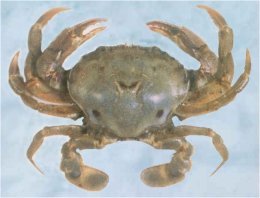 PADDLE CRAB: (Ovalipes catharus)
PADDLE CRAB: (Ovalipes catharus)
This crab is also known as the swimming crab.
They are found in the surf areas, on most exposed sandy beaches throughout New Zealand. They have also been found as far south as the Chatham Islands.
They are most commonly seen from around the low tide level, out to about 10 mts (30ft) depth, but they do occur deeper waters out to 100 mts (330ft) in a few areas.
The most I have seen would be on the West Auckland beaches when surf fishing. Paddle crabs appear to be more abundant around the North Island, but are seen and grow to a larger size in the South Island. They can be very aggressive and will nip your toes and soles of your feet if you stand on the sand over the spot where they lie hidden.
The smaller crabs being mostly females are a pale greyish brown colour with numerous brown speckles, with smooth limbs and carapace. The larger crabs normally males are generally darker in colour.
They have a distinct central broad "V" mark and four dark blotches on the back, but they are most distinguished by the broad paddle shaped back legs which are perfectly adapted for both swimming and digging in loose sand.
The width of the carapace (body) is up to 12 cm (4½") for females and to 15 cm (5¾") for males.
The paddle crabs breeding season is between September and May, the females are able to produce up to three lots or batches of up to 750,000 eggs. The larve float around offshore for about two months befor settleing in sheltered waters.
The young growth very fast, and they reach maturity within in one or two years. At this time the adults are quite migratory, and movie along the coastline as well as between deeper water and the surf zone.
The paddlecrabs eat any sort of animal material including live shellfish such as cockles, pipis, tuatua, and dead fish.
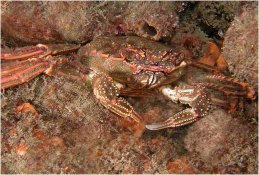 RED CRAB: (Plagusia chabrus)
RED CRAB: (Plagusia chabrus)
This crab is very commom around NZ in both the North and South Islands. It is found amongst seaweed covered rocks at low tide. Small ones are found inside rock pools at low tide, but divers have seen these crabs over reefs and rocks down to about 25 mts (80ft).
Although they live mainly on rocky reefs, they may venture on the sand to search for food at night.
These crabs are a light terracota red colour, and have sharp serrations around the edge of the carapace and ridged legs, the female is recognised by her smaller nippers. Each nipper has three knobbly ridges. They are also covered with short, stiff, brownish hairs. These fine hairs are beleived to give the crab an advantage when attacked by octopus, their main predator. Once lodged inside a crevice, an octopus won't be able to dislodge it. The red rock crab always lives under water and seldom venture outside of this enviroment.
This crab does not seem to be territorial but may put up a fight when foraging or courting. It is aggressive to other species of crab. They are very fast and will frequently attack if one enters the water near to it. They show no fear.
The adult red crabs can grow up to 7cm (2") across the carapace and can measure up to 20cm (7.8")across the legs.
The small crabs are mainly herbivorous, whereas large crabs are more carnivorousIts. They feed mainly on brown and red algae, although they will scavenge as well on limpets, chitons, gastropods, mussels, brittle stars and barnacles.
They breed from around mid September then the females carry the eggs about 0.4mm in size, around to about February.
Just before hatching these minute eggs change colour from a terracota red to light green colour. During the release of the hatched larvae, the female assists by flexing her body up and down, vibrating her abdomen and pulling the hatching eggs from her pleopods with her nippers. Juveniles and small crabs moult throughout the year, but large crabs moult mainly in winter between May and September, just before the breeding season.
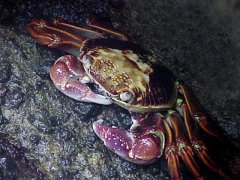 LARGE SHORE CRAB: (Leptograpsus variegatus)
LARGE SHORE CRAB: (Leptograpsus variegatus)
This large crab is quite often known and called the purple rock crab.
The large shore crab is found in the southern warm temperate waters of New Zealand from the top of the North Island down to Kaikoura or Westport in the South Island. They are also found in the Indian and Pacific Oceans from western Australia to America.
This large crab is found between the high tide mark and above it, often occupying moist crevices up to two metres above high tide. They can remain out of the water for days, but they are equally happily submerged.
This crab is an aggressive crab, but it is also extremely wary and scuttle away into crevices when disturbed. With their back to the wall he always has his claws raised and open ready to contest with any intruder. When wedged into a crevice they are not easily dislodged.
When handling a ferocious crab like this it requires a little bit of skill, and one risks painful nips.
This crab is found about half tide over rocky ground, particularly on the west coast of Auckland. They are a mottled dull reddish purple and white colour with some bright violet colorization around the edges.
Their legs are flattened and smooth, and the carapace (body) is approximately square with oblique folds at the sides.
The purple rock crab is the largest native shore crab and grows to about 150mm (6in) across, exceeded in size only by paddle crabs. Its long flat legs fold neatly together as in an oriental fan, giving it a very flat profile.
The purple rock crab is active particularly by night, when it leaves its crevice, scaling the vertical rocks and navigating its way over the rock flats and into the water. At night it has no fear and can be approached and photographed from close up.
This crab is an omnivore, feeding on both animal and plant matter such as seaweeds, plankton slime and small flea mussels, barnacles. Large crabs migrate all the way down the shore where food is more abundant.
The purple rock crab mates between October November when the female is hard-shelled. Before mating, the crabs make leg contact, during which the legs are rapidly vibrated. The male crab may then mount the underside of the female.
The female moults before laying her eggs. Females with eggs are found from November till February The incubation period is about 6 weeks and the crab spawns only once a year. Newly laid eggs are about 0.36mm in diameter, and develop from a dark brown colour to light brown just before hatching.
The female carries between 55,000 and 144,000 eggs (depending on her size), attached to her pleopods under her broad abdomen.
These crabs can live to about five years old.
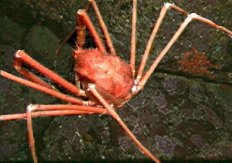 SPIDER CRAB: (family Majidae)
SPIDER CRAB: (family Majidae)
This crab is a truly wonderful crab, unfortunately restricted to the southern parts of New Zealand. Also known as the Southern spider crab and Auckland Islands crab.
Their habitat areas are from the outer Otago shelf southwards to Campbell Island, but most common on the Pukaki Rise and at the Auckland Islands.
They are found from the shoreline out to at least 200 mts (656ft), their depth varying with locality and season, as well as sex.
This crab is a reddish brown to orange in colour, and usually blotched. The young are very spiny.
The males reach at least 20 cm (7¾") and have large clawed arms up to 40 cm (15½") long. The females being some what smaller reach about 14 cm (5½") across the back.
The adults are also very spiny, also recognised by having three pairs of very long walking legs, and a soft asymmetric abdomen.
The different depth variations are also related to their reproductive cycle. Mating occurs in the shallow water in spring around October and November. After which the males appear to move to deeper water.
The females carry eggs through out most of the year, releasing larvae the following September.
Some large fish and some sealions feed on the spider crabs.
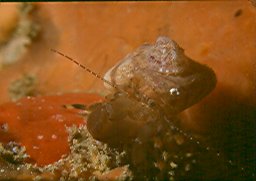 HERMIT CRAB: (Eupagurus novaezelandiae)
HERMIT CRAB: (Eupagurus novaezelandiae)
This crab is found all around our coasts. You will see most of them scurrying around in either estuaries or any muddy and sandy areas at low tide. Around rock areas, rock pools, under rocks and in deeper water up to about 15mts (50ft). There are about 800 species of hermit crabs.
You will always see them not very far from water because hermits have gills that must be keep moist or wet to survive.
This species of crab is some what different than other crabs, the main difference is that they posess a hard exoskeleton that protects all of the body except the abdomen. The abdomen is hook shaped and very soft and vulnerable to predators. Hermit crabs inhabit the empty shells of gastropods (one-shelled mollusks), the abdomen is asymmetrical and twisted so that is fits easily into the coils of the shell.
The abdomen is anchored into the shell by uropods, (sickle shaped hooks) being part of the crab’s tail.
This design is to enable the hermit to occupy an empty spiral shell as a temporary refuge, and protection.
I say temporary because as the hermit crab grows larger, shells also need to be larger for continued occupation. This house hunting must be a complicated business for hermits, for they have also to undergo the normal crustacean moulting period as well.
Hermit crabs do not kill snails for their shells. They inspect prospective shells very thoroughly before finding or changing shells. Sometimes if a hermit crabs cannot find a readily available and suitable shell, anything hollow will be used until they can find something better.
The hermit crabs have five pairs of legs. The first pair, the chelipeds (claws) are considered the first pair of legs. The right one is usually larger than the left and is used to block the entrance of the shell. Both claws are used for gathering food.
The next two pairs of legs, three and four are developed and used for walking. The other two pairs the sickle shaped uropods are much smaller and always kept within the shell.
Hermit crabs often have special relationship with other organisms in which both benefit. One example is that an anemone might attach itself to the top of the crab’s shell. The crab may benefit by gaining camouflage, and the anemone gets a free ride to various food supplies as the crab searches for its own food.
With some types of hermits the fertilization occurs internally, while in others, fertilization is external and occurs at the moment of egg laying. The developing eggs are attached to the abdominal swimmerets present only in the females. A female is able to carry several thousand eggs into the water.
The newly hatched hermit crabs are known as larvae. These young crabs live as microscopic plankton for several weeks before settling to the bottom and searching for a shell to inhabit.
I have read that hermit crabs can live from 6 to 15 years, but many live only to 6 to 12 months. I do not know however if this is true or not.